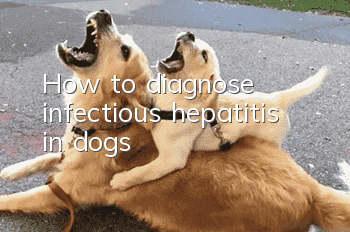How to diagnose infectious hepatitis in dogs

As one of the three major infectious diseases in dogs (canine distemper, canine parvovirus, and canine infectious hepatitis), canine infectious hepatitis mainly causes morbidity and death in puppies with low immunity, and is often associated with canine distemper or other bacterial diseases. , parasitic diseases and other mixed infections, causing serious consequences.
But parents, don’t frown in a hurry, because with proper care and timely treatment, canine infectious hepatitis is not that scary.
Infectious canine hepatitis:
Infectious canine hepatitis is an acute septic infectious disease that affects multiple systems caused by canine infectious hepatitis virus (CAV).
1. Risk groups
This disease mainly affects canines (raccoons and black bears can also be infected), especially puppies that have not been vaccinated/incompletely vaccinated within 1 year of age. The mortality rate is as high as 25%-40%. Adult dogs are rarely infected. onset.
2. High incidence season
The disease has no obvious seasonality, but the incidence is higher in winter and spring.
3. Symptoms/Signs
Canine infectious hepatitis viruses are mainly divided into CAV-1 and CAV-2, which cause hepatitis and respiratory infectious hepatitis respectively. In the early stage, they often show discomfort, lack of appetite, elevated body temperature, vomiting, diarrhea and abdominal pain. Later, some dogs may develop symptoms such as jaundice and corneal turbidity. The specific symptoms are as follows:
· Hepatitis type:
Extremely eager to drink a lot of water (this is the period of high mortality);
The body temperature rises to about 40-41℃, which lasts for 1-3 days, and then rises again about 1 day after it drops to normal temperature;
Vomiting, frequent diarrhea, and sometimes blood in the stool;
Abdominal pain;
Watery nasal fluid;
Mucous membrane flushing, gums and oral cavity bleeding;
Glaucoma and corneal perforation may occur;
Temporary light blue corneal opacity may occur during the recovery period, commonly known as "hepatitis blue eye disease";
Jaundice, a slight yellowish discoloration of mucous membranes, skin, etc., may occur.
· Respiratory type:
Accelerated breathing, coughing, and discharge of serous or purulent nasal fluid;
Increased body temperature;
As the disease progresses, it will further lead to increased heart rate, irregular heartbeat, and swollen lymph nodes and tonsils.
Note: The symptoms of this disease are similar to those of canine distemper, so they are often confused. However, if neurological symptoms such as convulsions, spasms, and foaming at the mouth occur, the dog is most likely to have canine distemper;The symptoms of respiratory infectious hepatitis are also similar to viral colds. Therefore, dogs need to be sent to the hospital for examination promptly after symptoms appear to avoid misdiagnosis and delaying the condition.
How to diagnose?
Hospitals usually use blood tests to conduct comprehensive analysis based on clinical symptoms and test results. If necessary, samples such as dog feces will be sent to the laboratory for virus isolation and identification.
· Laboratory indicators
Decreased white blood cells or lymphocytes;
Proteinuria or bilirubinuria occurs in many cases;
Lower blood sugar;
Serum alanine aminotransferase (ALT), aspartate aminotransferase (AST), and alkaline phosphatase are elevated;
Bile acids are elevated.
Note: There is currently no effective rapid diagnostic test paper, and scientific researchers are intensively researching and developing it. The current diagnostic test paper on the market has large errors and is not recommended for use.
Infection channels/methods:
· Sick dogs and newly recovered dogs can emit viruses through various secretions and excretions. The virus has strong survivability in the environment and can adhere to dog utensils for 6 to 9 months. Therefore, sick dogs and Recovering dogs are the main source of infection of this disease.
· Puppies are mainly infected through the digestive tract.
· Pregnant female dogs infected with the virus can infect the fetus through the placenta and cause fetal death.
· Respiratory cases can be infected through the respiratory tract.
· The virus is transmitted through ectoparasites.
How to treat canine infectious hepatitis:
There is no specific treatment for viral diseases. On the basis of symptomatic treatment, anti-virus, liver protection, secondary infection control and correction of water and electrolyte balance disorders are generally used. If a dog shows symptoms of suspected infectious hepatitis, parents can refer to the following treatment methods while sending the dog to the hospital.
· Specific treatment
Use canine infectious hepatitis hyperimmune serum or canine immunoglobulin promptly in the early stages of the disease (canine antibiotics also have the same effect).
· Liver-protective treatment
Intravenous infusion of 10% glucose solution, ATP, and inosine, intramuscular injection of Telox, vitamin C, and coenzyme A once a day; thymosin once every other day.
· Antivirus
Intramuscular injection of interferon, acyclovir, polymyosin, ribavirin, or oral administration of morphine hydrochloride.
· Control secondary infections
Ampicillin and kanamycin were injected intramuscularly.
· Control jaundice
20-40ml of Kuhuang injection can be added to the intravenous injection of glucose solution. Dogs without jaundice do not need the injection.
Note: For treatment methods of eye diseases such as keratitis and corneal opacity, please refer to previous issues. (Portal: Correct understanding of cat eye diseases)
During the treatment process, vitamin A, vitamin D and vitamin E can be appropriately added to the feed to improve the dog's own immunity. If the dog can survive for more than 48 hours, it is more likely to recover. Hepatitis blue eye does not require treatment and may resolve on its own after recovery from the disease. The specific treatment plan needs to follow the doctor's instructions.
How to avoid infection:
· Get vaccinated
Artificial vaccination is the fundamental way to prevent and treat the disease. Puppies should be vaccinated for the first time 45 days after birth, with a total of three injections of quadruple (or five or six) vaccines, with an interval of 15-21 days between each injection, and then a booster vaccination once a year. Puppies under 45 days of age that have not received breast milk should be carefully cared for first, and then vaccinated under the guidance of a professional animal doctor until they are healthy and strong.
· Comprehensive disinfection
Regularly disinfect the kennel and equipment with 10% to 20% bleach solution or 2% to 4% caustic soda water, or high temperature disinfection.
· Improve diet
Reasonably match the dog's diet, provide balanced nutrition, and appropriately add vitamin C, etc. to improve the dog's own immunity.
·Isolate sick dogs
Prevent healthy dogs from coming into contact with sick dogs/dogs who have recovered less than 9 months old and the items they have touched.
Note:
· Hyperimmune serum can be used for emergency prevention, but the protection period is limited to 2 weeks.
· Unvaccinated dogs that have just arrived in a new environment need to gradually adapt to their diet and life, and they can only be vaccinated after at least one week.
· Dogs that have just been vaccinated cannot take a bath within 7 days to prevent death from colds and fever.
· It is recommended that families/kennels that have raised sick dogs with infectious hepatitis wait at least 1 year before accepting new dogs.
· Canine infectious hepatitis has strong resistance to ether, chloroform, alcohol, etc. When using caustic lye for disinfection, you must take protective measures and wear gloves to avoid injury.
Warm tips:
If your dog is unwilling to take medicine, parents can try the following two methods to help it take it.
· Grind the medicine directly (suitable for smaller pills)/pulverize it into food and mix it with food
· To feed directly, pinch the middle part of the upper and lower jaw near the ears. The dog will automatically open its mouth. Then put the medicine behind the dog's tongue and pinch the closed mouth for about 20 seconds. (Dogs will swallow subconsciously)
Note: If the target of direct feeding is a large dog, it can be completed with the help of others. Usually, if the dog licks its nose, it means it has swallowed the medicine.
- How to train a golden retriever to defecate in the toilet? Golden retriever toilet training!
- What are the benefits of wearing a muzzle on your dog when going out?
- Dogs that are poisoned usually die within a few days.
- How do you treat your dog if he suffers from depression?
- What should I do if my dog eats the ham wrapper?
- Why does a dog’s belly turn black?
- Causes, symptoms and treatments of dog eczema
- What to look out for when buying a Mastiff puppy
- What causes fungal infections in dogs
- The puppy is too young, how to determine how old the puppy is?



